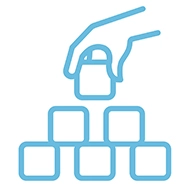Applied Behavior Analysis (ABA)

Are you seeking a transformative approach that transcends boundaries and empowers individuals of all ages and abilities? At MIND, we believe in the incredible potential of ABA to create positive lasting change across diverse environments such as home, school and community.
Applied Behavior Analysis (ABA) applies the science of behavior in a meaningful way to decrease challenging behaviors while optimizing learning to foster growth and enhance an individual’s overall quality of life. With a strong emphasis on understanding behavior and its environmental influences, ABA is an evidence-based approach that provides valuable insights into the learning process. Through fun and engaging activities, ABA sessions will work on reducing negative behaviors that may be barriers to learning or inclusion within the community.
At MIND, we understand that every child is unique, and ABA is not a one-size-fits-all approach. Each ABA program is meticulously tailored to the individual, considering their unique skill set, family dynamics, interests, and needs. To ensure the highest quality of care, our qualified and trained behavior analysts oversee the design and implementation of each program.
The ABA Journey at MIND:
- Comprehensive Assessment: Our Board-Certified Behavior Analyst (BCBA) conducts a thorough assessment to identify necessary interventions, provide feedback to parents and professionals, and monitor skill progress.
- Establishing Specific Goals: Based on the child’s age and ability level, we establish specific goals and objectives. These goals are broken down into simple, achievable steps for your child.
- Data-Driven Progress Monitoring: Progress is continuously measured through data collection during therapy sessions. Our BCBA regularly reviews the data and makes adjustments to the programs to ensure ongoing progress and success.
- Collaboration: The ABA team collaborates with other members of your child’s care team such as SLT and OT, as well as schools and nurseries, to ensure progress extends beyond the therapy room. The ABA team also offers parent, nanny and school shadow training to ensure therapy consistency and thus better goal achievement.
General Goals of ABA at MIND:
Our ABA therapy focuses on improving the following areas:
- Increase positive behaviors
- Communication and language
- Daily living skills
- Social skills
- Academic skills
- And much more!
At MIND, we are dedicated to providing the highest quality ABA, fostering positive changes, and empowering children to reach their fullest potential.
